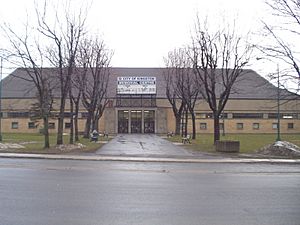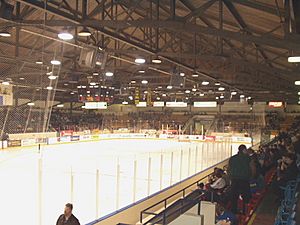Kingston Memorial Centre facts for kids
The Kingston Memorial Centre is a large building in Kingston, Ontario, Canada. It's a place where many different events happen, like sports and concerts. It opened in 1951 and was built to be a "living memorial." This means it helps people remember Kingston residents who bravely gave their lives in World War I, World War II, and the Korean War.
The Memorial Centre property is quite big. It includes the main arena with an ice rink, a new outdoor swimming area, farm buildings, softball fields, a running track, and even a park for dogs. The land has been owned by the public since 1841. It's important to Kingston's history, showing its past in farming, military, and fun activities.
Contents
Sports and Entertainment at the Centre
The Memorial Centre has been home to many exciting sports teams. For a long time, it was where the Kingston Frontenacs ice hockey team played. Before them, other teams like the Kingston Canadians and Kingston Raiders also called it home. The Frontenacs played their last game here in 2008 before moving to a new arena downtown called the Leon's Centre.
Even after the Frontenacs moved, the Memorial Centre stayed busy. It became the main place for the Queen's Golden Gaels university hockey team. It's also used for figure skating and other ice sports. Local hockey teams, like those from the Church Athletic League, also play here.
Beyond sports, the Memorial Centre has hosted many fun events. Famous musicians like Johnny Cash and Kingston's own The Tragically Hip have performed concerts here. In 2010, it became the home for the Kingston Derby Girls, a women's roller derby team.
Kingston Fall Fair and Community Events
The Kingston Memorial Centre is famous for hosting the annual Kingston Fall Fair. This fair has been a tradition in Kingston since 1830! It's one of the oldest fairs in Ontario, attracting over 16,000 visitors each September. The fair aims to teach people about agriculture, and it even has one of the biggest dairy shows in Ontario.
In 2012, a new farmers' market started at the Memorial Centre. The Memorial Centre Farmers’ Market sells local food grown within about 100 kilometers of Kingston. Its goal is to help people find and buy food that is grown in a sustainable way.
History of the Memorial Centre Land
The idea of agricultural societies, which help farmers, started early in Canada. In 1792, John Graves Simcoe, the first leader of Upper Canada (now Ontario), helped create the Agricultural Society of Upper Canada. This group encouraged farming through local societies and fairs.
The Frontenac Agricultural Society, which runs the Kingston Fair today, held its first fair near Kingston in 1825. Over the years, the fair moved to different locations. In 1880, the society bought the land where the Memorial Centre now stands. They even moved a special building called the Crystal Palace to this new site.
In 1897, the agricultural association sold the land to the City of Kingston. Maps from 1915 show that the property had many buildings for animals and exhibitions, a grandstand, and a half-mile race track.
Building the Memorial Centre
After World War II, people in Kingston wanted to build a special place to remember those who died in the wars. In 1944, the City of Kingston decided to help create the Kingston Community Memorial Health and Recreation Centre. They planned to raise money from the community and also contribute city funds.
By 1945, people had donated a lot of money for the centre. In 1950, the Canadian and Ontario governments also provided funds. However, the federal money was specifically for agricultural projects, so the centre had to be dedicated to farming activities as well as being an arena.
Working Together: City and Agricultural Society
In 1950, the City of Kingston and the Agricultural Society made an agreement. This agreement helped fund the centre and outlined how both groups would use it. The Agricultural Society would have the right to use the fairgrounds and buildings for the annual Fall Fair. The city would manage the arena for sports and other events throughout the year.
Saving the Memorial Centre
In the early 2000s, the Memorial Centre was getting old and needed repairs. There were discussions about whether to fix it up or build a brand new facility. Some people even suggested selling parts of the Memorial Centre land to help pay for a new downtown arena.
However, many people in the community loved the Memorial Centre and wanted to save it. They signed petitions and spoke to the City Council, reminding everyone that the centre was a "living Memorial" and an important public space. They pointed out that the area around the centre needed green spaces and recreational facilities.
In November 2005, the Kingston City Council listened to the community. They voted to keep the Memorial Centre as a public community facility. They also decided to create a committee to plan how to make the entire 23-acre site better.
Making the Centre Better
The committee's job was to create a plan to improve the Memorial Centre site. They wanted to make it a great place for recreation and a fitting memorial to Kingston's war heroes. They worked with many groups, including the Agricultural Society, to make sure the plans met everyone's needs.
Over the years, many improvements have been made. These include:
- Easy-to-use walking paths.
- An off-leash dog park.
- New swimming pools, including a splash pad and a lazy river.
- A running track.
- Continued support for the Fall Fair.
- Softball fields.
- New memorial gardens and walls.
- A pollinator garden to help bees and butterflies.
Kingston Memorial Centre Advisory Committee
Today, there is a special committee that advises the City of Kingston about the Memorial Centre. This committee helps decide on upgrades, future plans, and community programs for the site.



